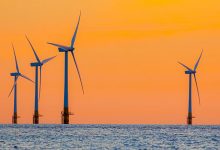Australia is letting a vast abundance of high-quality wind energy go to waste, due to government prohibitions on offshore wind developments, and lifting them could unlock more clean energy than Australia could ever need, according to a new research report.
An assessment of Australia’s offshore wind potential produced by the Blue Economy Cooperative Research Centre found that Australia has a massive amount of untapped offshore wind potential – estimated to be as much as 2,233GW of ‘technically accessible’ wind resources across Australia’s exclusive economic zone.
“[We] evaluated the ‘technically accessible resource,’ which included areas less than 100 km from shore, in water depths less than 1000m, within 100 km of sub-stations and transmission lines and excluding environmentally restricted areas,” the paper says.
“The technical resource was estimated to be 2,233GW; far in excess of current and projected electricity demand across the Australian electricity markets.”
The research has been produced by the Blue Economy CRC along with contributions from research institutions that included the CSIRO, the Institute for Sustainable Futures at the University of Technology Sydney, and several key union groups, and was supported with funding from the federal government.
While the installation of wind turbines in offshore locations can present greater technical and logistical challenges compared to conventional onshore turbines – going offshore has the promise of access to more powerful and more consistent winds that boost overall productivity.
Offshore turbines can be built taller and with longer blades, boosting efficiency and gaining access to stronger winds. Current offshore turbine designs can produce as much as 15MW each, allowing for a rapid scale-up of production.
The research found that in some parts of southern Australia, including off the coasts of Tasmania, the resource is so strong that capacity factors could exceed 80 per cent – matching output from many ‘baseload’ generators.
Capacity factors across other parts of Australia, including other parts of Tasmania, Western Australia and South Australia approached 50 per cent, exceeding what can be achieved by the highest performing onshore wind farms.
“Offshore wind has the potential to contribute to the energy system through higher capacity factors and diversity of energy supply,” said CSIRO’s Mark Hemer, who leads the Blue Economy CRC.
“This is particularly important under ‘energy superpower’ scenarios including mass electrification and hydrogen production.”
Global development of offshore wind resources has accelerated as part of a broader shift to lower emissions energy sources, with combined global targets expected to drive the addition of 200GW of offshore generation capacity by 2030.
No offshore projects have ever been developed in Australian waters, although there are currently more than ten projects proposed to be built in Australian waters, with a combined generation capacity of more than 25GW.
However, these projects are currently blocked by federal legislation that effectively prohibits the construction of offshore wind farms. The most advanced project, the Star of the South wind farm is proposing to build 2,000MW of new capacity off the coast of Victoria.
The Morrison government has indicated that it will move to lift the regulatory prohibitions, but since the release of a consultation paper last year, progress appears to have stalled.
Blue Economy CRC says offshore wind should be included in federal and state planning regimes, as well as in future energy market scenarios being prepared by bodies like the Australian Energy Market Operator.
Unions called on both federal and state governments to support proposals for new offshore wind developments, saying they represented a significant opportunity to great new high-skilled jobs in Australia.
“We know that a net zero emission, renewable energy-powered economy is necessary to limit the worst impacts of climate change,” Maritime Union of Australia National Secretary Paddy Crumlin said.
“Australia has highly skilled seafarers and offshore oil and gas workers capable of constructing offshore wind projects. An offshore wind industry would provide the opportunity for these workers to transition into the important work of delivering Australia’s clean energy future.”
See also RenewEconomy’s Offshore Wind Farm Map of Australia










